Jingyang Zhang
Helen
SADA: Stability-guided Adaptive Diffusion Acceleration
Jul 23, 2025Abstract:Diffusion models have achieved remarkable success in generative tasks but suffer from high computational costs due to their iterative sampling process and quadratic attention costs. Existing training-free acceleration strategies that reduce per-step computation cost, while effectively reducing sampling time, demonstrate low faithfulness compared to the original baseline. We hypothesize that this fidelity gap arises because (a) different prompts correspond to varying denoising trajectory, and (b) such methods do not consider the underlying ODE formulation and its numerical solution. In this paper, we propose Stability-guided Adaptive Diffusion Acceleration (SADA), a novel paradigm that unifies step-wise and token-wise sparsity decisions via a single stability criterion to accelerate sampling of ODE-based generative models (Diffusion and Flow-matching). For (a), SADA adaptively allocates sparsity based on the sampling trajectory. For (b), SADA introduces principled approximation schemes that leverage the precise gradient information from the numerical ODE solver. Comprehensive evaluations on SD-2, SDXL, and Flux using both EDM and DPM++ solvers reveal consistent $\ge 1.8\times$ speedups with minimal fidelity degradation (LPIPS $\leq 0.10$ and FID $\leq 4.5$) compared to unmodified baselines, significantly outperforming prior methods. Moreover, SADA adapts seamlessly to other pipelines and modalities: It accelerates ControlNet without any modifications and speeds up MusicLDM by $1.8\times$ with $\sim 0.01$ spectrogram LPIPS.
F^2TTA: Free-Form Test-Time Adaptation on Cross-Domain Medical Image Classification via Image-Level Disentangled Prompt Tuning
Jul 03, 2025Abstract:Test-Time Adaptation (TTA) has emerged as a promising solution for adapting a source model to unseen medical sites using unlabeled test data, due to the high cost of data annotation. Existing TTA methods consider scenarios where data from one or multiple domains arrives in complete domain units. However, in clinical practice, data usually arrives in domain fragments of arbitrary lengths and in random arrival orders, due to resource constraints and patient variability. This paper investigates a practical Free-Form Test-Time Adaptation (F$^{2}$TTA) task, where a source model is adapted to such free-form domain fragments, with shifts occurring between fragments unpredictably. In this setting, these shifts could distort the adaptation process. To address this problem, we propose a novel Image-level Disentangled Prompt Tuning (I-DiPT) framework. I-DiPT employs an image-invariant prompt to explore domain-invariant representations for mitigating the unpredictable shifts, and an image-specific prompt to adapt the source model to each test image from the incoming fragments. The prompts may suffer from insufficient knowledge representation since only one image is available for training. To overcome this limitation, we first introduce Uncertainty-oriented Masking (UoM), which encourages the prompts to extract sufficient information from the incoming image via masked consistency learning driven by the uncertainty of the source model representations. Then, we further propose a Parallel Graph Distillation (PGD) method that reuses knowledge from historical image-specific and image-invariant prompts through parallel graph networks. Experiments on breast cancer and glaucoma classification demonstrate the superiority of our method over existing TTA approaches in F$^{2}$TTA. Code is available at https://github.com/mar-cry/F2TTA.
Phi: Leveraging Pattern-based Hierarchical Sparsity for High-Efficiency Spiking Neural Networks
May 16, 2025Abstract:Spiking Neural Networks (SNNs) are gaining attention for their energy efficiency and biological plausibility, utilizing 0-1 activation sparsity through spike-driven computation. While existing SNN accelerators exploit this sparsity to skip zero computations, they often overlook the unique distribution patterns inherent in binary activations. In this work, we observe that particular patterns exist in spike activations, which we can utilize to reduce the substantial computation of SNN models. Based on these findings, we propose a novel \textbf{pattern-based hierarchical sparsity} framework, termed \textbf{\textit{Phi}}, to optimize computation. \textit{Phi} introduces a two-level sparsity hierarchy: Level 1 exhibits vector-wise sparsity by representing activations with pre-defined patterns, allowing for offline pre-computation with weights and significantly reducing most runtime computation. Level 2 features element-wise sparsity by complementing the Level 1 matrix, using a highly sparse matrix to further reduce computation while maintaining accuracy. We present an algorithm-hardware co-design approach. Algorithmically, we employ a k-means-based pattern selection method to identify representative patterns and introduce a pattern-aware fine-tuning technique to enhance Level 2 sparsity. Architecturally, we design \textbf{\textit{Phi}}, a dedicated hardware architecture that efficiently processes the two levels of \textit{Phi} sparsity on the fly. Extensive experiments demonstrate that \textit{Phi} achieves a $3.45\times$ speedup and a $4.93\times$ improvement in energy efficiency compared to state-of-the-art SNN accelerators, showcasing the effectiveness of our framework in optimizing SNN computation.
Which Agent Causes Task Failures and When? On Automated Failure Attribution of LLM Multi-Agent Systems
Apr 30, 2025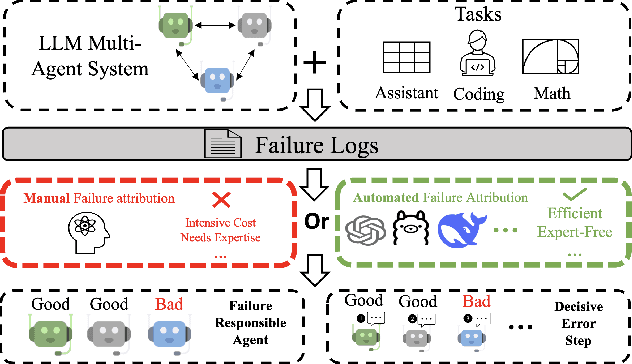
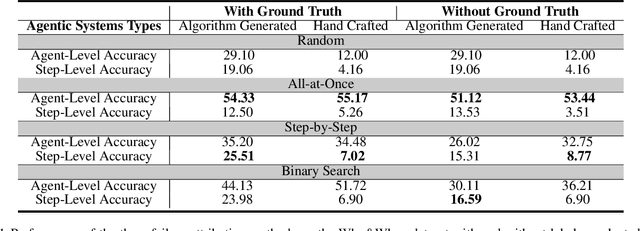

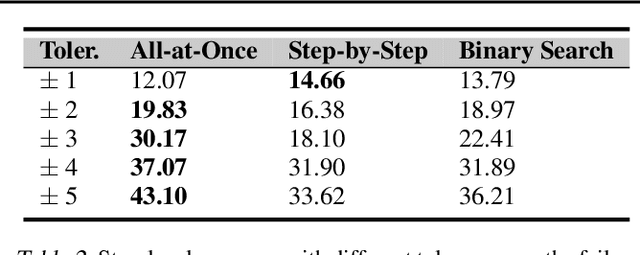
Abstract:Failure attribution in LLM multi-agent systems-identifying the agent and step responsible for task failures-provides crucial clues for systems debugging but remains underexplored and labor-intensive. In this paper, we propose and formulate a new research area: automated failure attribution for LLM multi-agent systems. To support this initiative, we introduce the Who&When dataset, comprising extensive failure logs from 127 LLM multi-agent systems with fine-grained annotations linking failures to specific agents and decisive error steps. Using the Who&When, we develop and evaluate three automated failure attribution methods, summarizing their corresponding pros and cons. The best method achieves 53.5% accuracy in identifying failure-responsible agents but only 14.2% in pinpointing failure steps, with some methods performing below random. Even SOTA reasoning models, such as OpenAI o1 and DeepSeek R1, fail to achieve practical usability. These results highlight the task's complexity and the need for further research in this area. Code and dataset are available at https://github.com/mingyin1/Agents_Failure_Attribution
Dynamic Allocation Hypernetwork with Adaptive Model Recalibration for Federated Continual Learning
Mar 25, 2025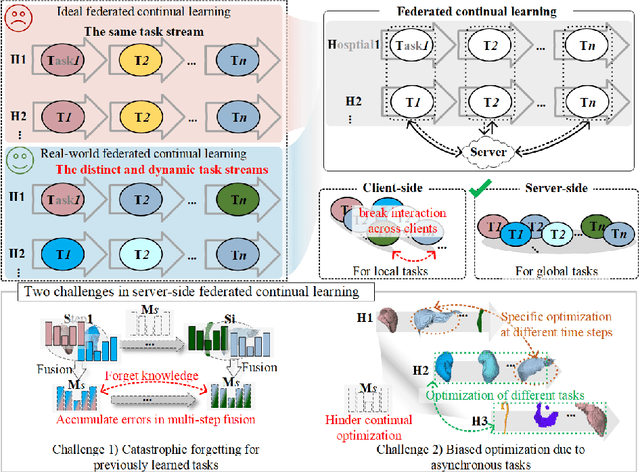

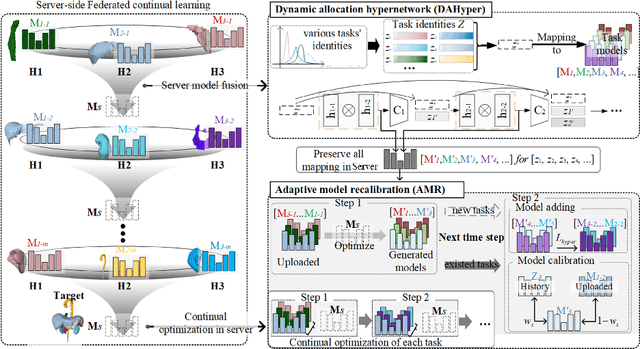

Abstract:Federated continual learning (FCL) offers an emerging pattern to facilitate the applicability of federated learning (FL) in real-world scenarios, where tasks evolve dynamically and asynchronously across clients, especially in medical scenario. Existing server-side FCL methods in nature domain construct a continually learnable server model by client aggregation on all-involved tasks. However, they are challenged by: (1) Catastrophic forgetting for previously learned tasks, leading to error accumulation in server model, making it difficult to sustain comprehensive knowledge across all tasks. (2) Biased optimization due to asynchronous tasks handled across different clients, leading to the collision of optimization targets of different clients at the same time steps. In this work, we take the first step to propose a novel server-side FCL pattern in medical domain, Dynamic Allocation Hypernetwork with adaptive model recalibration (FedDAH). It is to facilitate collaborative learning under the distinct and dynamic task streams across clients. To alleviate the catastrophic forgetting, we propose a dynamic allocation hypernetwork (DAHyper) where a continually updated hypernetwork is designed to manage the mapping between task identities and their associated model parameters, enabling the dynamic allocation of the model across clients. For the biased optimization, we introduce a novel adaptive model recalibration (AMR) to incorporate the candidate changes of historical models into current server updates, and assign weights to identical tasks across different time steps based on the similarity for continual optimization. Extensive experiments on the AMOS dataset demonstrate the superiority of our FedDAH to other FCL methods on sites with different task streams. The code is available:https://github.com/jinlab-imvr/FedDAH.
A Causality-Inspired Model for Intima-Media Thickening Assessment in Ultrasound Videos
Mar 16, 2025Abstract:Carotid atherosclerosis represents a significant health risk, with its early diagnosis primarily dependent on ultrasound-based assessments of carotid intima-media thickening. However, during carotid ultrasound screening, significant view variations cause style shifts, impairing content cues related to thickening, such as lumen anatomy, which introduces spurious correlations that hinder assessment. Therefore, we propose a novel causal-inspired method for assessing carotid intima-media thickening in frame-wise ultrasound videos, which focuses on two aspects: eliminating spurious correlations caused by style and enhancing causal content correlations. Specifically, we introduce a novel Spurious Correlation Elimination (SCE) module to remove non-causal style effects by enforcing prediction invariance with style perturbations. Simultaneously, we propose a Causal Equivalence Consolidation (CEC) module to strengthen causal content correlation through adversarial optimization during content randomization. Simultaneously, we design a Causal Transition Augmentation (CTA) module to ensure smooth causal flow by integrating an auxiliary pathway with text prompts and connecting it through contrastive learning. The experimental results on our in-house carotid ultrasound video dataset achieved an accuracy of 86.93\%, demonstrating the superior performance of the proposed method. Code is available at \href{https://github.com/xielaobanyy/causal-imt}{https://github.com/xielaobanyy/causal-imt}.
Keyframe-oriented Vision Token Pruning: Enhancing Efficiency of Large Vision Language Models on Long-Form Video Processing
Mar 13, 2025Abstract:Vision language models (VLMs) demonstrate strong capabilities in jointly processing visual and textual data. However, they often incur substantial computational overhead due to redundant visual information, particularly in long-form video scenarios. Existing approaches predominantly focus on either vision token pruning, which may overlook spatio-temporal dependencies, or keyframe selection, which identifies informative frames but discards others, thus disrupting contextual continuity. In this work, we propose KVTP (Keyframe-oriented Vision Token Pruning), a novel framework that overcomes the drawbacks of token pruning and keyframe selection. By adaptively assigning pruning rates based on frame relevance to the query, KVTP effectively retains essential contextual information while significantly reducing redundant computation. To thoroughly evaluate the long-form video understanding capacities of VLMs, we curated and reorganized subsets from VideoMME, EgoSchema, and NextQA into a unified benchmark named SparseKV-QA that highlights real-world scenarios with sparse but crucial events. Our experiments with VLMs of various scales show that KVTP can reduce token usage by 80% without compromising spatiotemporal and contextual consistency, significantly cutting computation while maintaining the performance. These results demonstrate our approach's effectiveness in efficient long-video processing, facilitating more scalable VLM deployment.
Proactive Privacy Amnesia for Large Language Models: Safeguarding PII with Negligible Impact on Model Utility
Feb 24, 2025Abstract:With the rise of large language models (LLMs), increasing research has recognized their risk of leaking personally identifiable information (PII) under malicious attacks. Although efforts have been made to protect PII in LLMs, existing methods struggle to balance privacy protection with maintaining model utility. In this paper, inspired by studies of amnesia in cognitive science, we propose a novel approach, Proactive Privacy Amnesia (PPA), to safeguard PII in LLMs while preserving their utility. This mechanism works by actively identifying and forgetting key memories most closely associated with PII in sequences, followed by a memory implanting using suitable substitute memories to maintain the LLM's functionality. We conduct evaluations across multiple models to protect common PII, such as phone numbers and physical addresses, against prevalent PII-targeted attacks, demonstrating the superiority of our method compared with other existing defensive techniques. The results show that our PPA method completely eliminates the risk of phone number exposure by 100% and significantly reduces the risk of physical address exposure by 9.8% - 87.6%, all while maintaining comparable model utility performance.
SuperGPQA: Scaling LLM Evaluation across 285 Graduate Disciplines
Feb 20, 2025Abstract:Large language models (LLMs) have demonstrated remarkable proficiency in mainstream academic disciplines such as mathematics, physics, and computer science. However, human knowledge encompasses over 200 specialized disciplines, far exceeding the scope of existing benchmarks. The capabilities of LLMs in many of these specialized fields-particularly in light industry, agriculture, and service-oriented disciplines-remain inadequately evaluated. To address this gap, we present SuperGPQA, a comprehensive benchmark that evaluates graduate-level knowledge and reasoning capabilities across 285 disciplines. Our benchmark employs a novel Human-LLM collaborative filtering mechanism to eliminate trivial or ambiguous questions through iterative refinement based on both LLM responses and expert feedback. Our experimental results reveal significant room for improvement in the performance of current state-of-the-art LLMs across diverse knowledge domains (e.g., the reasoning-focused model DeepSeek-R1 achieved the highest accuracy of 61.82% on SuperGPQA), highlighting the considerable gap between current model capabilities and artificial general intelligence. Additionally, we present comprehensive insights from our management of a large-scale annotation process, involving over 80 expert annotators and an interactive Human-LLM collaborative system, offering valuable methodological guidance for future research initiatives of comparable scope.
Step-Audio: Unified Understanding and Generation in Intelligent Speech Interaction
Feb 18, 2025Abstract:Real-time speech interaction, serving as a fundamental interface for human-machine collaboration, holds immense potential. However, current open-source models face limitations such as high costs in voice data collection, weakness in dynamic control, and limited intelligence. To address these challenges, this paper introduces Step-Audio, the first production-ready open-source solution. Key contributions include: 1) a 130B-parameter unified speech-text multi-modal model that achieves unified understanding and generation, with the Step-Audio-Chat version open-sourced; 2) a generative speech data engine that establishes an affordable voice cloning framework and produces the open-sourced lightweight Step-Audio-TTS-3B model through distillation; 3) an instruction-driven fine control system enabling dynamic adjustments across dialects, emotions, singing, and RAP; 4) an enhanced cognitive architecture augmented with tool calling and role-playing abilities to manage complex tasks effectively. Based on our new StepEval-Audio-360 evaluation benchmark, Step-Audio achieves state-of-the-art performance in human evaluations, especially in terms of instruction following. On open-source benchmarks like LLaMA Question, shows 9.3% average performance improvement, demonstrating our commitment to advancing the development of open-source multi-modal language technologies. Our code and models are available at https://github.com/stepfun-ai/Step-Audio.
 Add to Chrome
Add to Chrome Add to Firefox
Add to Firefox Add to Edge
Add to Edge